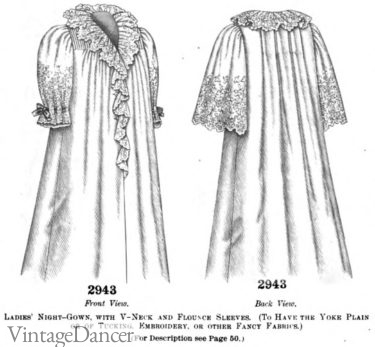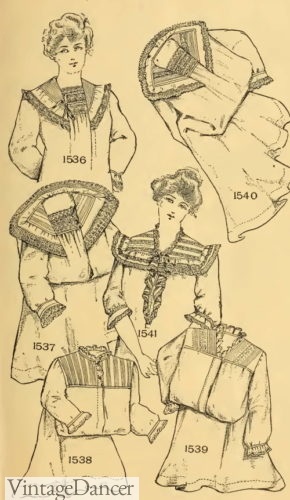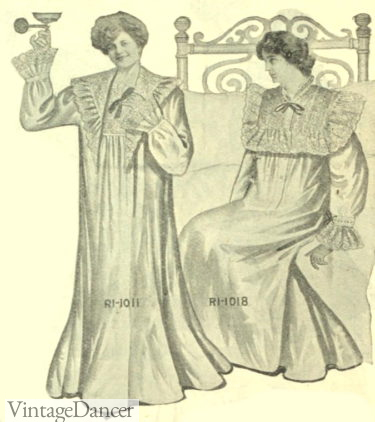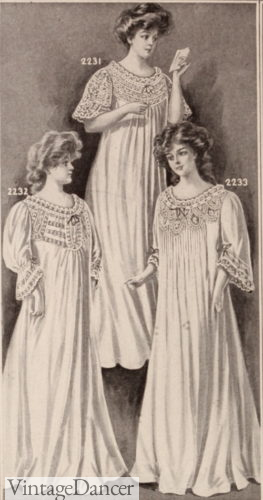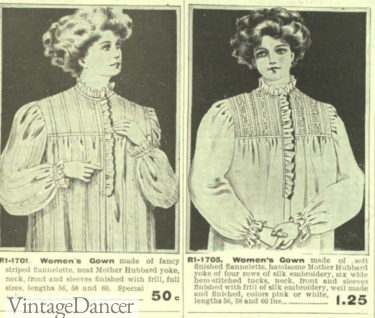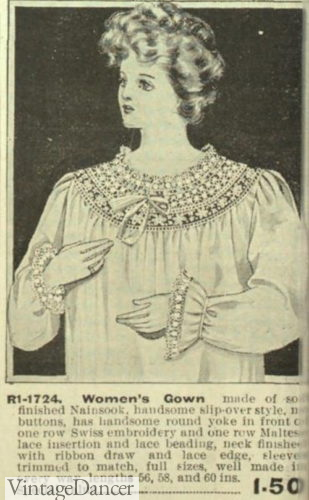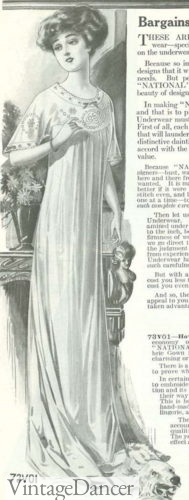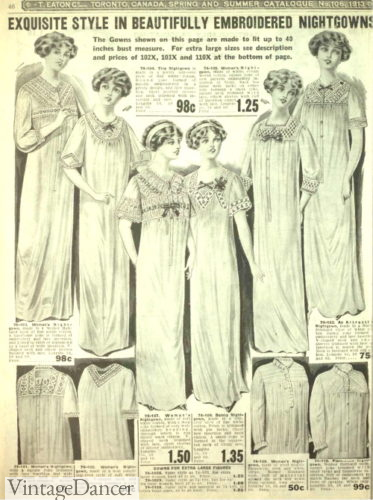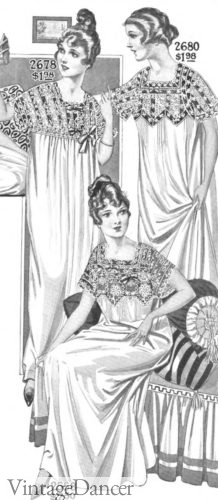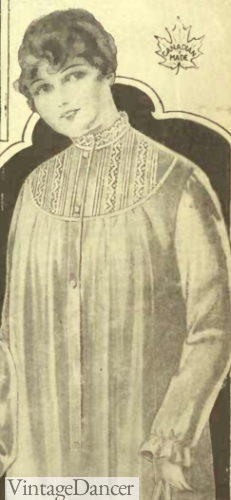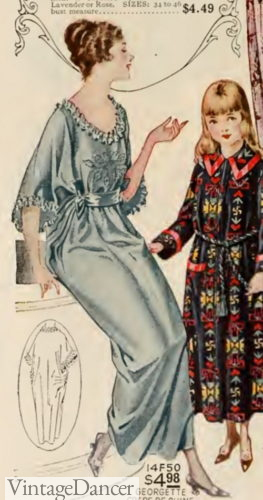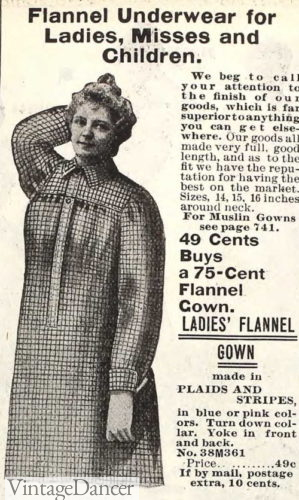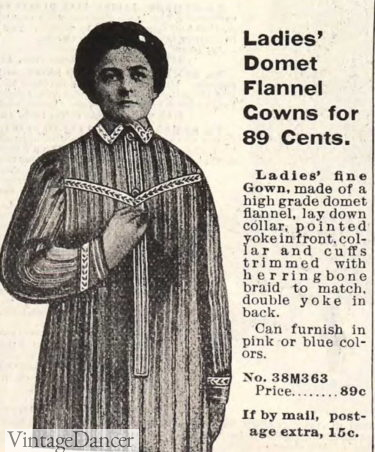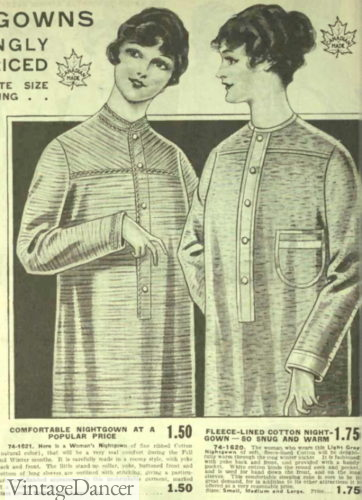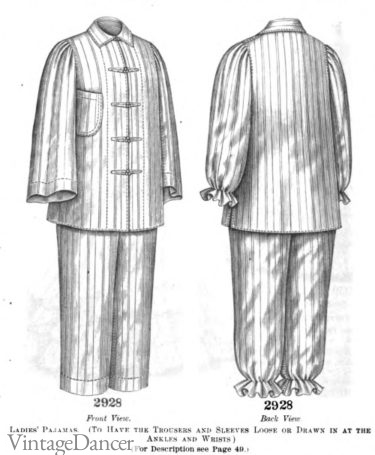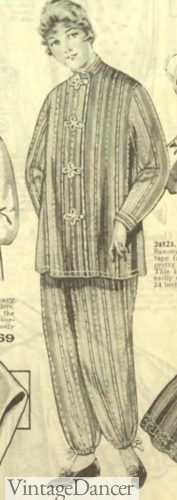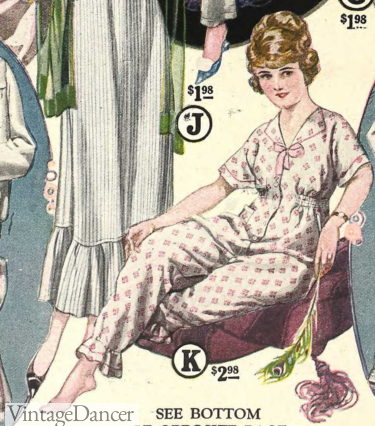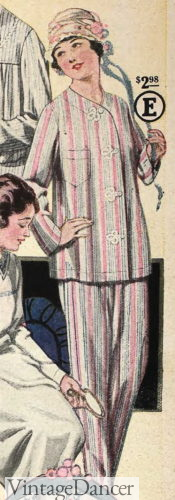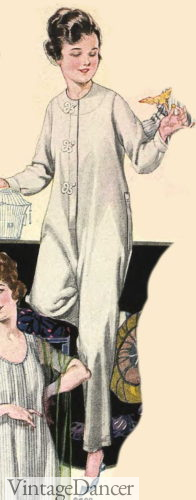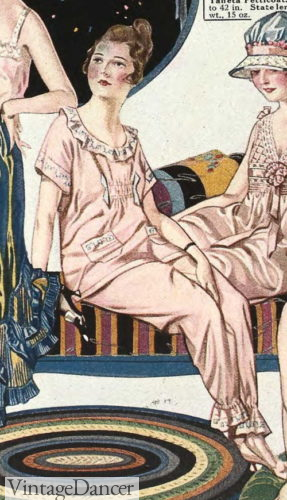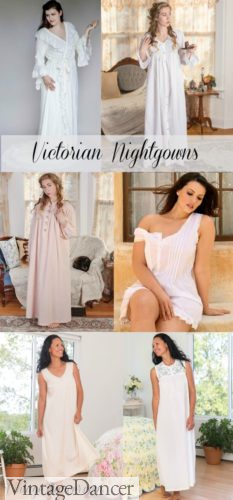The Victorian and Edwardian nightgown has come back into fashion. Long white cotton nightgowns with ruffles, lace and pleating are romantic, comfortable and timeless. The #cottagecore fashion trend has also turned some Edwardian inspired pajamas and peasant dress nightgowns into a new style of sleepwear.
Let us explore some of the key styles and history of Edwardian nightgowns and late 1910s pajamas for women.
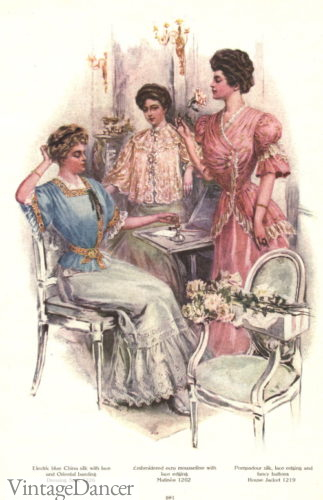
1907 Nightgowns and Dressing Gowns
Princess Nightgowns
Cotton, linen, nainsook, cambric, flannel or silk nightgowns were what most women wore at the turn of the century. They were long sleeved and ankle-length with a loose and wide fit.
The nightgown tops were heavily embroidered around the neck in a large round or square “mother Hubbard” yoke, trimmed in lace, and embellished with ribbon, bows, braid, and ruffles. The Victorian high neckline was gone and now small V necks, squares, and round holes let women’s necks breathe in comfort.
In summer, sleeves shortened to the elbow with wide, puff shoulders and bell shaped sleeves. Most gowns were white, however pink and sometimes blue were also available to purchase or sew at home.
- 1899 Nightgowns
- 1902 Nightgowns
- 1904 Winter Nightgowns
- 1908 Nightgowns
- 1909 Mother Hubbard Necklines
- 1909 Round Yoke Neckline
1910s nightgowns slimmed down into lean columns. Long sleeves were narrow and short sleeves were small bells. Embellishment still focused on the upper neck (above the bust) and sleeves. Most trim was flat, light, and very dainty. Soft lace, sparse embroidery, tiny bows, and thin ruffles trimmed these Grecian inspired gowns.
White was still the dominant nightgown color until after WWI, when young women turned to blues, pinks, and “flesh” colored nightwear.
- 1911
- 1913
- 1915
- 1915
- 1917
- 1918
- 1918
- 1919
Winter Nightgowns
In the heart of winter, a cotton or even light flannel nightgown was not warm enough. Instead, women wore heavy flannel, wool, or cotton ribbed nightshirts that resembled those worn by men. They were plain with a shirt collar, long button plaquette, and optional chest pocket. A little bit of lace, braid, or ruffle could be added for a bit more femininity.
Winter colors were natural wool (tan), grey, blue, pink and various prints of checks, stripes, and plaid.
- 1901 Check Flannel Nightshirt
- 1901 Stripe Flannel Nightgown
- 1907 Wool Nightshirt
- 1918 Rib Knit Wool Nightgowns
Edwardian Pajamas
In the late Victorian era, some women were beginning to wear two piece pajamas, however they didn’t become very trendy until after WWI.
Ziegfeld Follies actress Bille Burke wore pink pajamas in one scene from Jerry in 1914. After that appearance, young women sought these new pajamas, which were similar to the overalls and coveralls many of them were wearing at home, on the farm, or in factories.
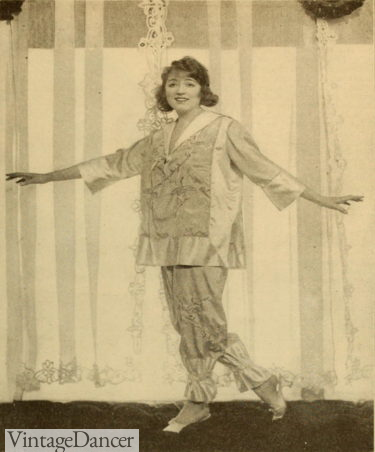
1917 Billie Burke and her Famous Pink Silk Pajamas
Pajamas came in one piece or two pieces. The two piece pajamas had a loose, boxy top with frog clasps and pearl buttons. The bottoms had a drawstring waistband and elastic ruffled cuffs. Some had ribbon ties instead of elastic. A plain trouser hem was also an option.
The one piece pajamas were a coverall or union suit style with a black flap for toilet needs. Closer to the 1920s, the pajama was embellished with bows, elastic gathers at the front or waist, ruffles, and embroidery. Vertical stripes, small prints, and pastel colors were more common than plain white.
- 1899 Pajamas
- 1918 Asian Pajamas
- 1919 Dotted Pajamas
- 1919 Stripe Asian Style Pajamas
- 1919 White Onesie Pajamas
- 1919 Pink Pajamas
Shop Nightgowns and Pajamas
Thanks to the Victorian and Edwardian revival, there are quite a few good designers of Victoriana nightgowns and pajamas. Some are very close to authentic, while others take light inspiration from sleepwear and dresses of the era.
Shop Victorian-Edwardian Nightgowns, Nightdress, Pajamas, Robes
- Shop all Vintage Nightgowns, Pajamas, Baby Dolls, Robes
- Shop New Vintage Slippers, House Shoes, Boudoir Shoes for Ladies
Read More Vintage Sleepwear History:
- Victorian Nightgown, Nightdress, Pajamas, Robes
- 1920s Nightgowns, Pajamas and Robes History
- 1940s Sleepwear: Nightgowns, Pajamas, Robes, Bed Jackets
- 1950s Sleepwear, Loungewear History and Shopping Guide
- 1960s & 1970s Lingerie & Nightgowns
Debbie Sessions has been teaching fashion history and helping people dress for vintage themed events since 2009. She has turned a hobby into VintageDancer.com with hundreds of well researched articles and hand picked links to vintage inspired clothing online. She aims to make dressing accurately (or not) an affordable option for all. Oh, and she dances too.
